The Bagpipe
Dutch: Doedelzak, PijpzakGerman: Dudelsack, Sackpfeife
Italian: cornamusa, zampogna
French: cornemuse, musette de cour
Classification and Etymology
As a wind instrument, the bagpipe belongs to the class of aerophones (whose sound is produced primarily by causing a body of air to vibrate, without the use of strings or membranes), where it is specified as a composite reed pipe. Its commonest form consists of a "chanter," one or more drones all supplied with air from the bag, either by means of a bellow compressed under the player's arm to provide a constant pressure as it is practiced with the musette de cour, or the Irish Uilleann pipe, producing a more delicate sound). It may also be blown by mouth through a blowpipe, intended for outdoor use as the sound is louder, well-known from the famous Scottish Great Highland bagpipe. The "chanter" is a cylindrical or conical bored pipe with a single or double reed and finger holes for playing the melody while a drone is a cylindrical tube with a single reed producing a constant bourdon tone.
The History of the Bagpipe
The bagpipe, with its venerable history, is one of the oldest musical instruments of mankind. The early ancestors of the bagpipe, the ancient reed-sounded single- or double-pipe (fig. 1), can be traced back to ancient Egypt and Middle-East (Babylonia, Mesopotamia). The invention of a bag as the air supply was merely an addition to the existing pipes. With the early double-pipes one of the pipes probably sounded the melody and the other the accompaniment, analogous to the later bag-blown instrument.
It is likely that the basic means of producing the sound in the pipes and reed is a discovery belonging to prehistory. Someone discovered that it was possible to produce a musical sound by pinching the flat end of a straw or plant-stalk and blowing into it with compressed lips. This first experiment became the principle of the double reed since the straw naturally produces two flattened surfaces or "blades" (fig. 2) at the squeezed part. These two blades vibrate under the pressure of the breath and produce sound. The earliest specimens of such reed-sounded pipes have been found in excavated tombs in Babylonia and Egypt.
The construction of a single reed (fig. 3), which is of special use in bagpipe drone(s), was a slightly more complicated invention since a knife blade was necessary. At some point, it was found that if a tongue was cut a little towards or away from one of the knots or natural nodes of a straw, and the player inserted the straw to the full length into his mouth and blew, a sound of superior quality could be produced. With such fragile material as a corn-stalk the single reed would be less liable to become clogged or sodden with the moisture of the mouth than the crushed end of the straw of the double reed.
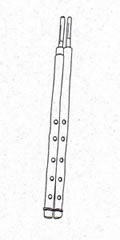
The earliest known depictions of the reed-pipe upon steles from Egypt and the Middle-East represent the double pipe. In the initial form, two duplicate pipes were closely bound together, the finger holes corresponded on each pipe, so that the melody could be played simultaneously by covering both corresponding holes. This kind of pipe produced twice as much volume as a single pipe, which improved outdoor playing. A further development was the use of wax to stop the finger holes in one of the pipes which produced an attractive drone accompanying the melody with a constant pitch. Soon the drone-pipe was deliberately constructed with only one hole; and very much later, its length was extended, so as to produce a truly bass note.

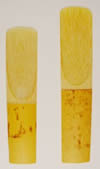
At the same time, though not necessarily in the same geographical regions, divergent pipes had evolved. The two pipes were separate, not bound together and each one held in a different hand. Each pipe contained its own reed and was inserted in the mouth diverging from the lips of the player at an acute angle to each other.
As only one hand could finger each pipe, each could have only four finger holes. Many divergent pipes, including a number of those from ancient Egypt, had four finger holes in the right-hand pipe and three in the left. From this version only a step was needed to experiment with making one the pipes sound different note from the other producing rudimentary harmony. Several holes of the second pipe were stopped up with wax leaving a few fingers free for playing the other. An early example of this type are the famous silver pipes in the Royal Cemetery of the ancient Sumerian city of Ur.North of the head of the Persian Gulf, mentioned already in the Bible as the city of the Chaldees from which the patriarch Abraham set out upon his journey to find the Promised Land). These divergent pipes are dated from about 2800 B.C. onwards.
From Egypt and the Middle-East the divergent pipes spread to Asia Minor to the Greek empire, and from there to Greece itself, by traders from Mediterranean and the Black Sea but above all with the conquest of Egypt in the fourth century B.C. by Alexander the Great. The first mention of these pipes in Greek literature is to be found in Homer's Iliad (c. 700 B.C.). The ancient Greek term for the reed-sounded mouth-blown divergent pipe is aulos (plural auloi), which, together with its Latin equivalent tibia (pl. tibiae) is incorrectly translated by practically every translator of the Greek and Latin classics as flutes. Both, in fact mean, musical pipes sounded by a reed and not the flute which, held transversely and cross-blown did not yet appear in Greek or Roman art in that times.To the mistranslation of aulos and tibia see Francis Collinson, The Bagpipe: The History of a Musical Instrument (London: Routledge Kegan & Paul, 1975), 22.
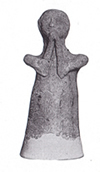
This error in translation becomes particularly evident in descriptions by Thucydides (c. 460––c. 400 B.C), Aristotle (384––322 B.C) and others, of the use of the pipes by the Spartans in battle. A flute, with its cold, austere tone, would never have been able to inflame the will to fight more than the pipe(s) with its rough and exciting sound. The pipes in ancient Greece were obviously not only a musical instrument for the male players but for female players (fig. 5) as well, as they had been in ancient Egypt, evident in numerous pictures and inscriptions. In the Greek theatre, particularly in the comedies of Aristophanes (c. 445–385 B.C.), the "girl-piper" has in the most cases an integral part (despite the fact that the female characters had always been played by young male actors).
Pipes made their way to Rome (fig. 6) from the Greek empire, possibly via the Etruscans or from Sicily, which had been colonized early by the Phoenicians (fig. 4) and later by the Greeks (Magna Graecia). However, pipes are mentioned quite early in Roman semi-history and tradition. The Greek historian and biographer Plutarch (46–127 A.C.), who on his extensive travels, spent two visits to Rome, credited the semi-mythical king Numa (the second King of Rome after Romulus, c. 750–671 B.C.) with the foundation of the original trade guilds of Rome, of which the Pipers' Guild got a privileged place. They played during the numerous religious ceremonies for the sacrifice of the gods, one of the customary duties of Roman life, at the public games, at chariot races (especially adapted for declaring the victory of the winner) or at funerals (no more than ten were allowed).
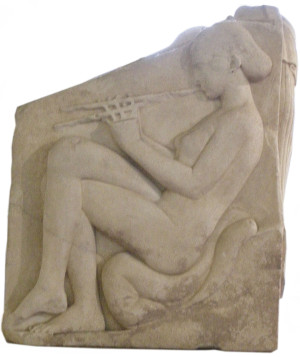
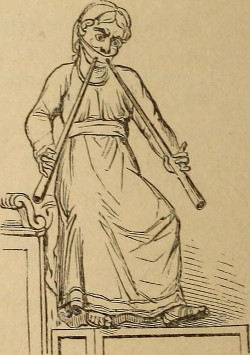
The Invention of the Bag
Even some of the Roman Emperors played the pipes, or were interested in them. The most spectacular imperial player was undoubtedly the Emperor Nero (37–68 A.C.). It is with him that the first concrete mention of the actual bagpipe is associated, although there had been vague suggestions centuries before of an instrument formed by a bag made of the whole skin of an animal, with chanter and/or drone inserted in it, for instance by Aristophanes in his Lysistrata or in The Acharnians (here in quite straightforward phrases). Moreover, one of a series of terracotta figurines from Alexandria (dated c. last century B.C.) shows a little man playing the pan-pipes (syrinx) accompanying himself by means of a bag holding under his arm, which by a pipe inserted into the bag obviously sounding a drone. These figurines seems to be the earliest representations of a kind of bagpipe.Francis Collinson, The Bagpipe: The History of a Musical Instrument (London: Routledge Kegan & Paul, 1975), 30f. and 42ff.
The prominent Roman historian and biographer Suetonius (c. 69/75–after 130) in his De Vita Caesarium ("Lives of the Twelve Caesars") tells us in his last days Nero (37–68 A.D.) had sworn to honor the gods with a great musical festival, wherein he would perform among others as an utricularius (utricularia = bag of skin for water or wine, here rather meant as a bag filled with air) if they would rescue him from the hands of the conspirators. At about the same time the Greek orator and historian of the Roman Empire, Dio Chrysostom (or Dion of Prusa, c. 40–120) wrote about Nero's skills in bagpipe playing rather sarcastically: "They say he can…play the aulos both with his mouth and also with his armpit, a big bag being thrown under it, in order that he might escape the disfigurement of Athena."Dio Crysostom refers here to the Greek myth of the goddess Pallas Athena who had made for herself a double reed-pipe and found that she could produce the most beautiful sound from the pipes. But as she recognized the barely hidden laughter of her fellow deities, although charmed by her music, she went to a lake where she was able to watch her reflection while she was playing and was quite shattered to see what a sight she looked with her cheeks puffed out caused by the ancient technique of blowing the pipes. Ancient pipers aided this technique by the use of a so-called phorbeia, a "cheek strap" to support the cheeks and ensure a steady pressure in them. Collinson 29 and plate 6. Nero even had the image of himself playing the bagpipe put on coins. From these sources there is no doubt that the real bagpipe, providing the wind for a reed-sounded chanter (or chanters) by means of an air reservoir—the bag—had appeared in the republic of Rome, dated at about the second half of the first century A.C. The poet Martial (40-c.104) called this new instrument askaulos, taken from the Greek aulos (pipe) plus askos for "bag."Francis Collinson, The Bagpipe: The History of a Musical Instrument (London: Routledge Kegan & Paul, 1975), 45.
The Bagpipe in Northern and Western Europe
With the invasion of Britain (at first by Caesar in 55 and 54 B.C., see his famous De Bello Gallico, later followed in 43 A.C. by Claudius) and the expansion of the Roman Empire, the bagpipe spread quickly over Europe, evident in the various types of bagpipes, like the gaita in Portugal and Spain, the gajda in the Balkan area resp. the gajdy in Eastern Europe, the duda in Hungary or the zampogna in the Italian area (as a direct descendant of the early Roman tibia utricularis as a merely adaptation of the bag principal to the divergent double-pipe, with two chanters).
Although the bagpipe apparently never had any official status as an instrument of the Roman army during the c. 350 years of the Roman presence there, it was played at the religious observances of the soldiers or at other, more secular occasions in their off-duty hours. And since there was plenty of fraternization between the Roman soldiers and the natives of Britain when the two nations were not engaged in warfare, the British people became aware of the Roman bagpipe and may very well have adapted it to their own instruments although there is only vague evidence from carvings or mosaics from that time.
More problems arise when we attempt to establish a link between the Roman double-pipes resp. the bagpipe and the probable ancestors of the nowadays Scottish Great Highland bagpipe. There is little doubt that the Highlanders (the Caledonians in those days), implacable enemies of the invading Romans, must have known all about the Roman tibia particularly from the Roman military altars along the fortified lines which always had a piper playing before it, as well as from civilian settlements near the Roman military base camps in southern Scotland. But despite their natural gift of music, they have totally rejected the Roman pipes. The ancient Egyptian parallel pipes, with their drone, resemble more closely to the today's full developed Highland pipes, but the question is how did this two-handed chanter and drone arrive in Britain, and in Scotland in particular. One of the various assumptions is that it had reached Scotland with immigrants from the Mediterranean by the way of the west coast between 2000 and 3000 B.C., or via Ireland with its close ties to Spain. It may also be that the Highlanders invented their pipes independently in pre-Roman times.
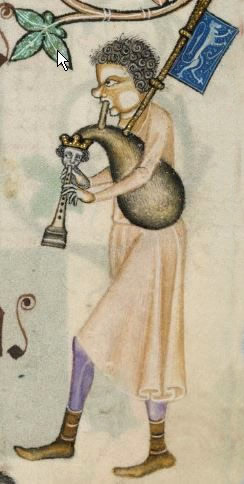
British Library, London
The instrument has a carved king's head, and a pennon with a heraldic lion.
Another attempt to explain how the chanter and drone principle reached the Scots is suggested by the appearance of what is generally called the "hornpipe," which is the pibcorn (or pibgorn) in Wales, made by shepherds, and later in Scotland the stock and horn. These were either single pipes or parallel double-pipes (drone form), made of sheep's thigh-bone or bower-tree with cow horn bell and oaten reed. Some of the Welsh pibcorn had the reed covered with a cap of horn, while the Scottish stock and horn showed a wooden reed cap. Their origin may lay in the ancient Phrygian aulos (fig. 8), appearing also a lot in the Roman period. The tubes had different lengths, the left one also looked like a horn. It is associated particularly with the Dionysios- and the Cybele-cult.
Such early hornpipesThe term "hornpipe" refers also to a lively traditional folk dance from the late seventeenth century, very popular particularly in England, Scotland and Ireland until today. It is generally thought to be a sailor's dance (hence the popular Sailor's Hornpipe) and is danced wearing hard shoes. There are several forms, either in even notes (4/4 or 2/2 times), or the baroque form in 3/2 or 3/4, often syncopated. Well-known examples of baroque hornpipe are Henry Purcell's Hornpipe Rondeau and the movement "alla hornpipe" from Georg Frederick Handel's "Water Music." (fig. 7) possibly had come with migrant invaders from the eastern Mediterranean at about 2000 B.C and might have originated with some megalithic cult.Francis Collinson, The Bagpipe: The History of a Musical Instrument (London: Routledge Kegan & Paul, 1975), 63. The majority of hornpipes are, however, double pipes played with an inflated bag of goatskin, cow's stomach or suchlike (fig. 9).
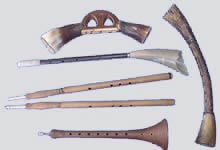
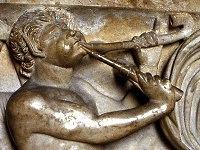
The bagpipe in Germany and the Low Countries
At about the end of fifteenth century/beginning of sixteenth century a second drone was added to the bag. One of the earliest and well-known depictions of this new addition had been made by the great German painter and graphic artist Albrecht Dürer (1471–1528) (fig. 10 & 11).
How Dürer came across his model of a player of perhaps an Irish piob mhór, the great Irish war-pipe, is not known. It might have been one of the pipers from the army of Henry VIII, who was on the Continent at this time, and Dürer may have had the chance to observe them.Francis Collinson, The Bagpipe: The History of a Musical Instrument (London: Routledge Kegan & Paul, 1975), 111.
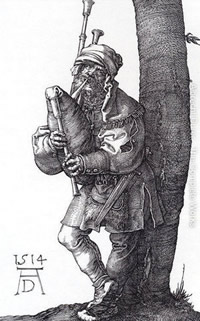
Dürerengraving 1514
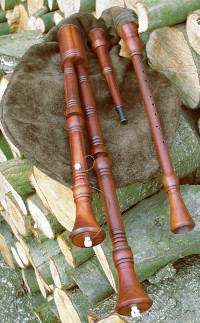
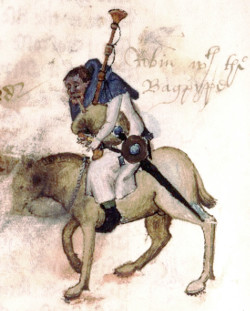
Canterbury Tales.
14th-century drawing
As already said, the bagpipes (fig. 12) had spread all over Europe in the times of the Roman invasions and enjoyed great popularity since the Middle Ages. The form and size of the instrument varied from area to area, but the principle of chanter, drone(s) and the bag was in most cases common elements. An early engraving of the German "Sackpfeife" (bagpipe) appears in Martin Agricola's Musica instrumentalis deudsch (1529), which shows two drones, probably of different length, probably for different tuning. This form seems to have established itself as the most popular one for a long time and was adopted by the Dutch/Flemish musicians, as it is evident from numerous Dutch and Flemish paintings showing pipers, especially from the seventeenth century.
In Michael Praetorius' Syntagma musicum, II ("Theatrum instrumentorum," 1618–1619) we find detailed descriptions and illustrations of various old German bagpipes (fig. 13), of which the Schäferpfeife (shepherd's pipe, called "Sackpfeife" (fig. 14) by Agricola and Sebastian Virdung in his Musica getutscht, 1511) was the one most widely spread in the Netherlands as well as over entire northern Europe up to the 18th century.
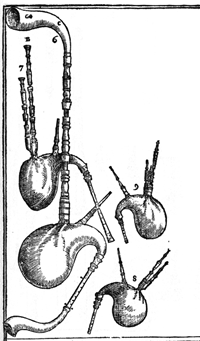
(a) Bock, (b) Schäferpfeife, (c) Hümmelchen,
(d) dudy (Czech name). Woodcut from Praetorius's Syntagma musicum II: "Theatrum instrumentorum" (1618–1619).

Well-known examples of Dutch and Flemish bagpipes (fig. 15 & 16) can be observed in Pieter Brueghel the Elder's cheerful pictures of peasants' weddings and dances.
Pieter Brueghel the Elder
1568
Oil on panel, 114 x 164 cm.
Kunsthistorisches Museum, Vienna
The running and jumping steps of the village-square dance are quite the contrary to the formal dances performed by the bourgeois circles of the upper class. The bagpiper plays a Flemish set with long drones of different length.
Pieter Bruegel the Elder
1567
Oil on panel, 124 x 164 cm.
Kunsthistorisches Museum, Vienna
Brueghel was probably the first and certainly the most renowned of contemporary genre painters who depicted bagpipers, both in paintings and etchings (see the extensive Bagpipe Iconography Page). His instruments still serve as models for many bagpipe makers today. On closer observation we see that the two drones are both fitted in one drone-stock perhaps to disperse the air into the drones more evenly.
In seventeenth-century Dutch painting it is above all Jan Steen (1626–1679) who depicted bagpipers performing at peasants feasts or in the family household (fig. 17).
Jan Steen
c. 1674
Oil on canvas, 110 x 135 cm.
London, Wellington Museum
Apsley House
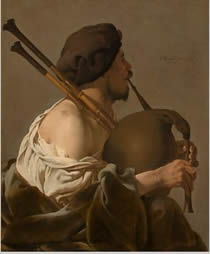
Hendrik Ter Brugghen
1624
Oil on canvas, 100.7 x 82.9 cm.
National Gallery of Art, Washington D.C.
This work shows a bagpipe as it is depicted by Agricola. Wallraf-Richartz-Museum Cologne.
There is even a Dutch proverb, very popular in the seventeenth century, which recalls to piping: Zou de ouden zongen, pijpen de jongen ("As the old sing so pipe/whistle the young"). Steen depicted this proverb several times, and his Merry Family (fig. 18) seems to belong to this group, with the warning that bad examples lead to bad results (i.e. the children are "piping/whistling" various wind instruments, trying the smoking pipes and drinking wine as their parents and grandparents do). The following picture (Soo voer gesongen, soo na gepepen, same meaning), similar in composition, but lighter in colors, is the largest one of this group, executed with extreme precision.
Click here for period bagpipe music:
An "Almayne" (Middle English for "Allemande"), played on Flemish shepherd's pipe and side drum by Diabolus in Musica.
The popularity of this proverb is also evident in a painting with the same subject by the Flemish painter Jacob Jordaens (1593–1678), one of Rubens' best pupils, here perhaps with a literary meaning as the grandparents are singing while the father is playing the bagpipe and the children are playing small flutes (recorders). Like Steen, Jordaens repeated this subject several times.
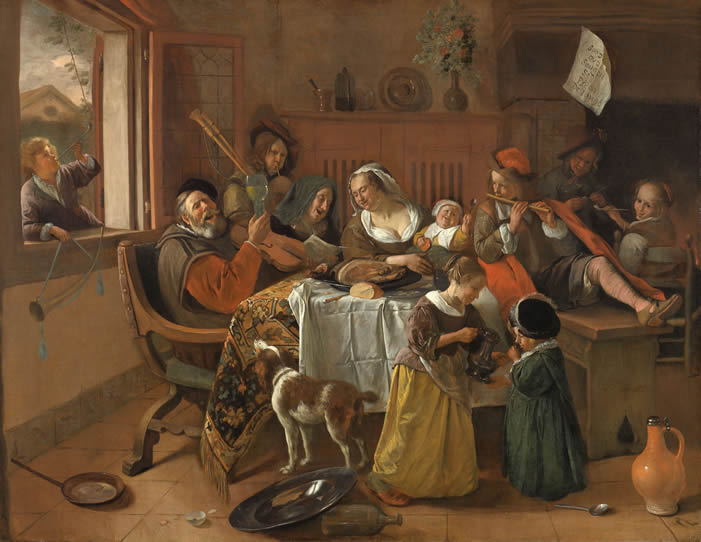
1668
Jan Steen
Oil on canvas, 110.5 x 141 cm.
Rijksmuseum, Amsterdam
This painting has a lot to do with "piping"either smoking a pipe or playing it. On the sheet of paper at the upper right side we can read the Dutch proverb "Zou de ouden zongen, pijpen de jongen."
The fourth renowned painter who rendered bagpipes (fig. 19 & 20) in the Golden Age was the Fleming David Teniers the Younger (1610–1690). Teniers, one of the most popular painters of the Flemish school in the seventeenth century (it is said, that Willem Kalf might have been influenced by him) developed a much more refined style of village scenes together with a remarkable painting technique of light brushwork and subtle coloring. He fulfilled an enormous number of commissions depicting humble peasants as the upper class wished to see them portrayed: as simple, unthinking creatures gratefully enjoying their humble existence. But Teniers always added a touch of humanity and good humor to his scenes.
An interesting detail may be seen in Teniers' Village Feast. It shows two places of dancing: one in the foreground with a hurdy-gurdy player, another one in short distance with a bagpipe player—if they had played different tunes it must have been rather a jarring noise than cheerful dance music, even though hurdy-gurdy and bagpipe can suit each other quite well for outdoor music with their buzzing sound, as the melody to the right may demonstrate.
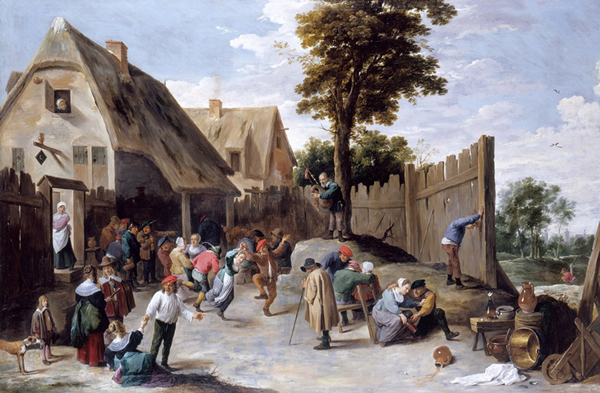
David Teniers the Younger
1645–1650
Royal Collection, Windsor
In the most cases the musicians are playing from a somewhat hightened point (a wine cask or a little rise beneath a tree) certainly to be better heard and seen, but perhaps also to distinguish them and their musical skills a bit from the common crowd.
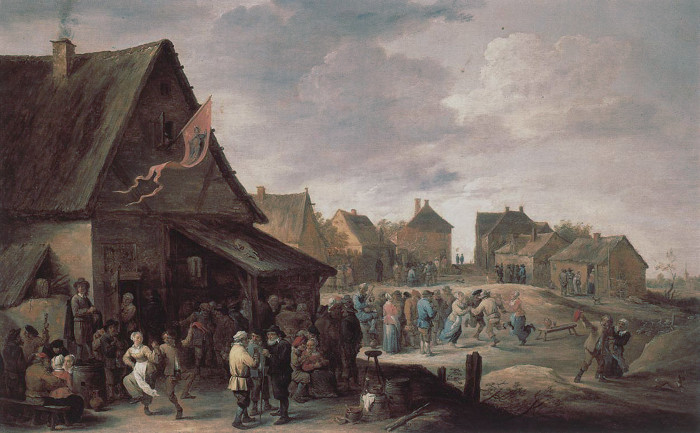
David Teniers the Younger
1652
Musées Royaux des Beaux-Arts, Brussels.
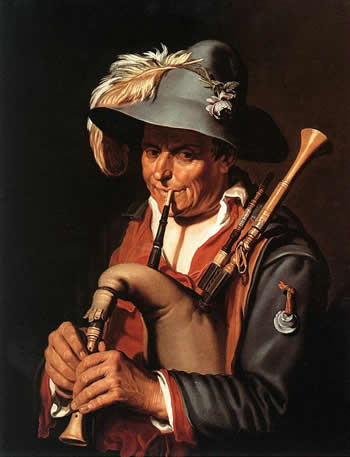
Abraham Bloemaert
Residenzgalerie, Salzburg
Perhaps this piper is playing a tranquil tune like the tune Sala (see MP3 sound file right).
An outstanding picture of a bagpiper in half-length (fig. 21) comes from Abraham Bloemaert (1564–1651). The details of the instrument are strikingly precise, but from a professional point of view, it seems that the model (or the painter) had scarce knowledge of the playing technique (especially the fingering).
In the Low Countries, representations of bagpipes can be found in other forms of art. They appear on "Delft Blue" tiles (fig. 22) which protected the lower edges of the white washed walls and are so typical of Vermeer's interiors and from many of his colleagues.

In the seventeenth and above all the 18th century, the bagpipe arose from its status as a popular folk instrument to one favored by French nobility and even at the Royal court of Louis XIV and Louis XV (in the form of the musette or musette de cour (see also The Hurdy-Gurdy). The musette, unique in its time with its delicate sound, was decorated lavishly with velvet or brocade and stuctural elements made of costly ebony and ivory. This particular instument is well worth a closer look.
Click here for period bagpipe music:
Valse Bouffard
performed by Dutch folk music group "Met Zak en As"
The name of this group has a funny double meaning: first it relates to the bagpipe ("zak") and the hurdy-gurdy ("as") = the crank with which the wheel of the hurdy-gurdy is getting turned.
The second meaning recalls the saying "To wear sackcloth and ashes," but rather as a joke, referring to the common folk and their music.
The Franco-Flemish tune "Sala," performed by Stefan Timmermans
Click here for period bagpipe music:
The Franco-Flemish tune "Sala,"
performed by Stefan Timmermans.
From the album Speelman, Gij Moet Strijken. Traditionele muziek uit Vlaanderen/Traditional Music from Flanders.
With kind permission by Davidsfonds, Belgium. (Association for Flemish Culture)